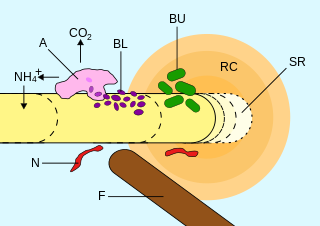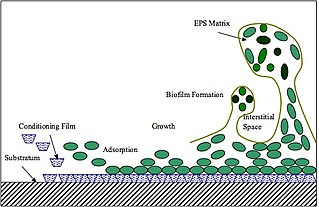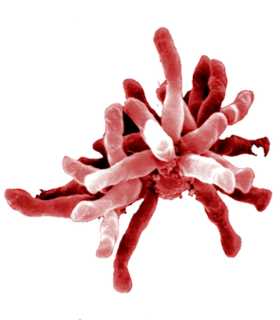Related Research Articles

Pseudomonas is a genus of Gram-negative, Gammaproteobacteria, belonging to the family Pseudomonadaceae and containing 191 validly described species. The members of the genus demonstrate a great deal of metabolic diversity and consequently are able to colonize a wide range of niches. Their ease of culture in vitro and availability of an increasing number of Pseudomonas strain genome sequences has made the genus an excellent focus for scientific research; the best studied species include P. aeruginosa in its role as an opportunistic human pathogen, the plant pathogen P. syringae, the soil bacterium P. putida, and the plant growth-promoting P. fluorescens, P. lini, P. migulae, and P. graminis.

The phylum Bacteroidota is composed of three large classes of Gram-negative, nonsporeforming, anaerobic or aerobic, and rod-shaped bacteria that are widely distributed in the environment, including in soil, sediments, and sea water, as well as in the guts and on the skin of animals.

Acidobacteriota is a phylum of bacteria. Its members are physiologically diverse and ubiquitous, especially in soils, but are under-represented in culture.

Agrobacterium radiobacter is the causal agent of crown gall disease in over 140 species of eudicots. It is a rod-shaped, Gram-negative soil bacterium. Symptoms are caused by the insertion of a small segment of DNA, from a plasmid into the plant cell, which is incorporated at a semi-random location into the plant genome. Plant genomes can be engineered by use of Agrobacterium for the delivery of sequences hosted in T-DNA binary vectors.

Legionella pneumophila is a thin, aerobic, pleomorphic, flagellated, non-spore-forming, Gram-negative bacterium of the genus Legionella. L. pneumophila is the primary human pathogenic bacterium in this group and is the causative agent of Legionnaires' disease, also known as legionellosis.

The rhizosphere is the narrow region of soil or substrate that is directly influenced by root secretions and associated soil microorganisms known as the root microbiome. The rhizosphere involving the soil pores contains many bacteria and other microorganisms that feed on sloughed-off plant cells, termed rhizodeposition, and the proteins and sugars released by roots, termed root exudates. This symbiosis leads to more complex interactions, influencing plant growth and competition for resources. Much of the nutrient cycling and disease suppression by antibiotics required by plants, occurs immediately adjacent to roots due to root exudates and metabolic products of symbiotic and pathogenic communities of microorganisms. The rhizosphere also provides space to produce allelochemicals to control neighbours and relatives.

Dickeya dadantii is a gram-negative bacillus that belongs to the family Pectobacteriaceae. It was formerly known as Erwinia chrysanthemi but was reassigned as Dickeya dadantii in 2005. Members of this family are facultative anaerobes, able to ferment sugars to lactic acid, have nitrate reductase, but lack oxidases. Even though many clinical pathogens are part of the order Enterobacterales, most members of this family are plant pathogens. D. dadantii is a motile, nonsporing, straight rod-shaped cell with rounded ends. Cells range in size from 0.8 to 3.2 μm by 0.5 to 0.8 μm and are surrounded by numerous flagella (peritrichous).

Stenotrophomonas is a genus of Gram-negative bacteria, comprising at least ten species. The main reservoirs of Stenotrophomonas are soil and plants. Stenotrophomonas species range from common soil organisms to opportunistic human pathogens, the molecular taxonomy of the genus is still somewhat unclear.
Pseudomonas citronellolis is a Gram-negative, bacillus bacterium that is used to study the mechanisms of pyruvate carboxylase. It was first isolated from forest soil, under pine trees, in northern Virginia, United States.

Pseudomonas stutzeri is a Gram-negative soil bacterium that is motile, has a single polar flagellum, and is classified as bacillus, or rod-shaped. While this bacterium was first isolated from human spinal fluid, it has since been found in many different environments due to its various characteristics and metabolic capabilities. P. stutzeri is an opportunistic pathogen in clinical settings, although infections are rare. Based on 16S rRNA analysis, this bacterium has been placed in the P. stutzeri group, to which it lends its name.
Methylorubrum extorquens is a Gram-negative bacterium. Methylorubrum species often appear pink, and are classified as pink-pigmented facultative methylotrophs, or PPFMs. The wild type has been known to use both methane and multiple carbon compounds as energy sources. Specifically, M. extorquens has been observed to use primarily methanol and C1 compounds as substrates in their energy cycles. It has been also observed that use lanthanides as a cofactor to increase its methanol dehydrogenase activity

Extracellular polymeric substances (EPSs) are natural polymers of high molecular weight secreted by microorganisms into their environment. EPSs establish the functional and structural integrity of biofilms, and are considered the fundamental component that determines the physicochemical properties of a biofilm.

Rhodopseudomonas palustris is a rod-shaped, Gram-negative purple nonsulfur bacterium, notable for its ability to switch between four different modes of metabolism.
Telmatobacter is a genus of bacteria in the family Acidobacteriaceae.
Geothrix fermentans is a rod-shaped, anaerobic bacterium. It is about 0.1 µm in diameter and ranges from 2-3 µm in length. Cell arrangement occurs singly and in chains. Geothrix fermentans can normally be found in aquatic sediments such as in aquifers. As an anaerobic chemoorganotroph, this organism is best known for its ability to use electron acceptors Fe(III), as well as other high potential metals. It also uses a wide range of substrates as electron donors. Research on metal reduction by G. fermentans has contributed to understanding more about the geochemical cycling of metals in the environment.
Variovorax paradoxus is a gram negative, beta proteobacterium from the genus Variovorax. Strains of V. paradoxus can be categorized into two groups, hydrogen oxidizers and heterotrophic strains, both of which are aerobic. The genus name Vario-vorax and species name para-doxus (contrary-opinion) reflects both the dichotomy of V. paradoxus metabolisms, but also its ability to utilize a wide array of organic compounds.
Bryocella elongata is a bacterium, a type species of genus Bryocella. Cells are Gram-negative, non-motile pink-pigmented rods that multiply by normal cell division and form rosettes. The type strain is SN10(T). B. elongata was first isolated in 2011 from a methanotropic enrichment culture.
Acidipila is a bacterial genus from the family of Acidobacteriaceae. All reported examples have been isolated from acidic substrates and are capable of growth on sugars
Acidithrix ferrooxidans is a heterotrophic, acidophilic and Gram-positive bacterium from the genus of Acidithrix. The type strain of this species, A. ferrooxidans Py-F3 was isolated from an acidic stream draining from a copper mine in Wales. This species grows in a variety of acidic environments such as streams, mines or geothermal sites. Mine lakes with a redoxcline support growth with ferrous iron as the electron donor. A. ferrooxidans grows rapidly in macroscopic streamer, producing greater cell densities than other streamer-forming microbes. Use in a bioreactors to remediate mine waste has been proposed due to cell densities and rapid oxidation of ferrous iron oxidation in acidic mine drainage. Exopolysaccharide production during metal substrate metabolism, such as iron oxidation helps to prevent cell encrustation by minerals.
Cytophagales is an order of non-spore forming, rod-shaped, Gram-negative bacteria that move through a gliding or flexing motion. These chemoorganotrophs are important remineralizers of organic materials into micronutrients. They are widely dispersed in the environment, found in ecosystems including soil, freshwater, seawater and sea ice. Cytophagales is included in the Bacteroidetes phylum.
References
- 1 2 3 4 Kishimoto, Noriaki; Kosako, Yoshimasa; Tano, Tatsuo (1991). "Acidobacterium capsulatum gen. nov., sp. nov.: An acidophilic chemoorganotrophic bacterium containing menaquinone from acidic mineral environment". Current Microbiology. 22 (1): 1–7. doi:10.1007/BF02106205. S2CID 20636659.
- 1 2 3 4 5 6 7 8 9 Naomi L.Ward; Jean F. Challacombe; Peter H. Janssen; Bernard Henrissat; Pedro M. Coutinho; Martin Wu; Gary Xie; Daniel H. Haft; Michelle Sait; Jonathan Badger; Ravi D. Barabote; Brent bradley; Thomas S. Brettin; Lauren M. Brinkac; David Bruce; Todd Creasy; Sean C. Daugherty; Tanja M. Davidsen; Robert J. Dodson; A. Scott Durkin; Anuradha Ganapathy; Michelle Gwinn-Giglio; Cliff S. Han; Hoda Khouri; Hajnalka Kiss; Sagar P. Kothari; Ramana madupu; Karen E. Nelson; William C. Nelson; Ian Paulsen; Kevin Penn; Qinghu Ren; M.J Rosovitz; Jeremy D. Selengut; Susmita Shrivastava; Steven A. Sullivan; Roxanne Tapia; L. Sue Thompson; Kisha L. Watkins; Qi Yang; Chunhui Yu; Nikhat Zafar; Liwei Zhou; Cheryl R. Kuske (2009). "Three Genomes from the Phylum Acidobacteria Provide Insight into the Lifestyles of These Microorganisms in Soils". Applied and Environmental Microbiology: 2046–2056.
- 1 2 Sabine Kleinsteuber; Frank-Dietrich Muller; Antonis Chatzinotas; Katrin Wendt-Potthoff; Hauke Harms (2008). "Diversity and in situ quantification of Acidobacteria subdivision 1 in an acidic mining lake". FEMS Microbiology Ecology. 63 (1): 107–117. doi: 10.1111/j.1574-6941.2007.00402.x . PMID 18028401.
- ↑ Barns, S. M.; Takala, S. L.; Kuske, C. R. (1999). "Wide Distribution and Diversity of Members of the Bacterial Kingdom Acidobacterium in the Environment". Applied and Environmental Microbiology. 65 (4): 1731–1737. doi:10.1128/AEM.65.4.1731-1737.1999. PMC 91244 . PMID 10103274.
- ↑ Suman R. Rawat; Minna K. Mannisto; Yana Bromberg; Max M. Haggblom (2012). "Comparative genomic and physiological analysis provides insights into the role of Acidobacteria in organic carbon utilization in Arctic tundra soils". FEMS Microbiology Ecology. 82 (2): 341–355. doi: 10.1111/j.1574-6941.2012.01381.x . PMID 22486608.
- 1 2 Pankratov, T. A., Kirsanova, L. A., Kaparullina, E. N., Kevbrin, V. V. and Dedysh, S. N. (2012). "Telmatobacter bradus gen. nov., sp. nov., a cellulolytic facultative anaerobe from subdivision 1 of the Acidobacteria, and emended description of Acidobacterium capsulatum Kishimoto et al. 1991." Int. J. Syst. Evol. Microbiol. 62:430–437.
- ↑ Kammler, M., C. Schon, and K. Hantke. (1993). "Characterization of the ferrous iron uptake system of Escherichia coli." J. Bacteriol. 175:6212–6219.
- ↑ Chaparro JM, Bhadri DV, Vivanco JM (2014). "Rhizosphere microbiome assemblage is affected by plant development". The ISME Journal. 8 (4): 790–803. doi:10.1038/ismej.2013.196. PMC 3960538 . PMID 24196324.
- 1 2 Anna M.Kielak; Matheus A.P.Cipriano; Eiko E. Kuramae (2016). "Acidobacteria strains from subdivision 1 act as plant growth‑promoting bacteria". Archives of Microbiology. 198 (10): 987–993. doi:10.1007/s00203-016-1260-2. PMC 5080364 . PMID 27339258.
 Material was copied from this source, which is available under a Creative Commons Attribution 4.0 International License.
Material was copied from this source, which is available under a Creative Commons Attribution 4.0 International License. - ↑ Rifat Hayat; Safdar Ali; Ummay Amara; Rabia Khalid; Iftikhar Ahmed (2010). "Soil beneficial bacteria and their role in plant growth promotion:a review". Annual Microbiology. 4: 579–598.